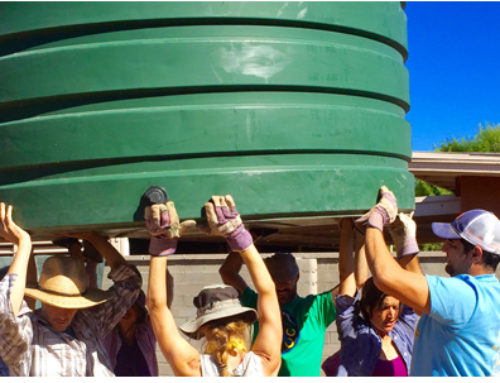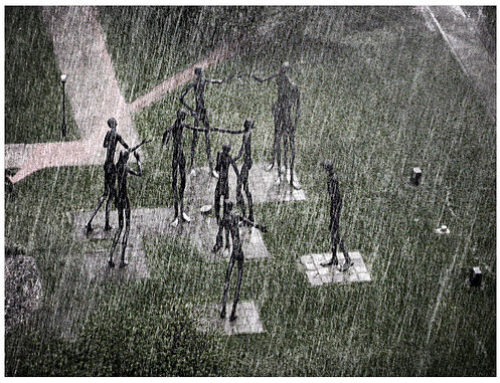-
I have to admit, when I first (mis)read the title of this article, all the hair went up on the back of my neck. NO! I yelled to the computer screen, worried that this was a new form of bottled water gone boxy. Instead, here’s an innovative idea that collects rainwater and delivers it directly to plants. I’d still like to see it in action. What do you think? (Thanks to Alex Lantsburg of SWALE for passing this on to me.)
Could Boxes of Water Help Reforest the World?
The WaterBoxx needs just 3 inches of rainfall per year to deliver a slow and steady supply of water to plants or trees
By Debra Kahn and ClimatewireFrom the land of dams and canals comes a new device billed as the savior of agriculture and reforestation in drought-plagued areas.
The “Waterboxx” is the brainchild of Dutch businessman Pieter Hoff, who sold his lily-growing operation in 2003 to focus on water. Then he started tinkering with a polypropylene box, about the size of a laundry basket. It has a fluted lid and a wick extending from the bottom. The plant sits in a cylindrical opening in the center that goes all the way through the box.
The mechanism is almost suspiciously simple. The box collects rainwater and condensation and funnels it to the plant. In spring 2009, Hoff partnered with Eduard Zanen, co-founder of the stroller company Bugaboo International, to finance experiments with the device that are now under way in Kenya, Morocco, Spain and the United States. Eight hundred of the boxes have been installed in Joshua Tree National Park, where they are nourishing native mesquite and saltbush plants.
Hoff, an impassioned climate evangelist, published a book in 2008 titled “CO2: A Gift From Heaven,” which argues that policymakers should leave the climate debate aside and focus on planting trees. Planting 5 billion acres of trees — about 2.5 times the surface area of Canada — would be enough to offset annual emissions of 10 billion metric tons of CO2, he calculates.
For Hoff, the box is the solution. It collects any amount of water — from inches of rainfall to minute droplets of condensation — and delivers it slowly and steadily. Just 3 inches of rainfall per year is enough to keep the box’s water supply replenished. It can also be screwed into the ground, both to prevent theft and to secure it to sloping or rocky land.
“We can use the box to reforest California, and we can use it to restore our water tables to safer levels again,” he said.
Margrit Mondavi, the widow of Napa Valley winemaker Robert Mondavi, christened two of the devices at her vineyard last week with a bottle of 1990 Reserve Cabernet Sauvignon. She called it an important development “because water is becoming more precious all the time.”
Matt Ashby, director of vineyards for Mondavi, is conducting an experiment with 500 Waterboxxes around new grapevines. He’ll compare their growth in the fall to a control group of 10,000 vines that are receiving conventional drip irrigation.
“I’m not sure why no one’s done it before,” he wondered, adding: “I’m convinced it’s going to work.”
First, add water
To start, the farmer fills the box partway with 2 gallons of water. Any condensation or rain is theoretically enough to keep the box filled and supplying enough water to the plant via the wick. The device is stoppered with a siphon to prevent evaporation. The box has to be oriented facing a certain way, so the oblong opening in the center points east-west and shades the plant from the sun during the hottest part of the day.The box is removed after the plant sends its roots deep enough to access groundwater. It can then be used over and over again.
Hoff said he has spent about $7 million on the project thus far, with about $500,000 coming from the Dutch government. He has been through more than 10 prototypes, and is also working on building one out of biodegradable material, for one-time use in remote areas like the Sierra Nevada.
Right now, Hoff sells the boxes for $275 for 10, manufactured in his native Holland, but he envisions local production wherever the box is sold. “I think it’s a disaster that the only people who know how to weave clothing are in China,” he said. Gardening and home-improvement stores could sell them for about $15, he said.
Although it does require initial watering, it still beats traditional irrigation, particularly in areas that are hard to reach. Richard Dale, executive director at the Sonoma Ecology Center, is planning to use the boxes along to replant the banks along Sonoma Creek. “Restoration can be challenging here because you have to get through the long, dry, Mediterranean summer,” he said. “This could really transform the way restoration is done in arid regions.”






